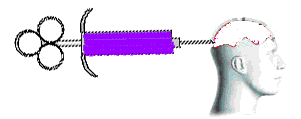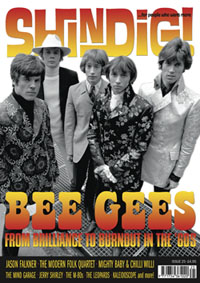1. The
Hypodermic Needle Theory
 This theory was the first attempt to
explain how mass audiences might react to mass media, since the 1920’s. As you
can see from this particular diagram, it demonstrates that audiences passively
receive the information by being “injected” into them via a media text,
without any attempt on their part to resist or challenge the data. Governments produced
propaganda to try and sway people towards their way of thinking, as they had just
discovered the power of advertising to communicate a message. Therefore, the
Hypodermic Needle Theory implies that the information from a text, passes into
the mass consciousness of the audience unmediated, i.e. the experience,
intelligence and opinion of an individual, are not relevant to the reception of
the text. Overall, it suggests that, as an audience, we are manipulated by the
creators of media texts, and we are powerless to refuse this idea, making our
thoughts easily changed by media-makers.
This theory was the first attempt to
explain how mass audiences might react to mass media, since the 1920’s. As you
can see from this particular diagram, it demonstrates that audiences passively
receive the information by being “injected” into them via a media text,
without any attempt on their part to resist or challenge the data. Governments produced
propaganda to try and sway people towards their way of thinking, as they had just
discovered the power of advertising to communicate a message. Therefore, the
Hypodermic Needle Theory implies that the information from a text, passes into
the mass consciousness of the audience unmediated, i.e. the experience,
intelligence and opinion of an individual, are not relevant to the reception of
the text. Overall, it suggests that, as an audience, we are manipulated by the
creators of media texts, and we are powerless to refuse this idea, making our
thoughts easily changed by media-makers.
2. Drip,
Drip, Drip Effect/The Cultivation Effect
This is where rather than be “injected” with information;
this theory implies the audience are more like patients you get in a hospital
on a slow drip feed. Therefore, it means if a message is repeated enough over a
long period of time, it will eventually have an effect on the audience. For
instance, the more violence you see over and over again it will make you less
sensitive on violence. An example of this could be when people constantly hear reporting
of on the television or in the newspapers,
heightens the audience’s fear on crime, as they believe it could happen to them,
if it could happen to someone else. This theory can also be known as the cultivation
differential.
3. Two-Step
Flow
As the mass media became an essential part of life in
societies all over the world and did NOT reduce populations to a mass of
unthinking drones, a more sophisticated explanation was invented. Paul
Lazarsfeld, Bernard Berelson, and Hazel Gaudet analysed the voters'
decision-making processes during a 1940 presidential election campaign and
published their results in a paper called The People's Choice. Their
findings implied that the information does not directly flow from the text into
the minds of its audience unmediated but is filtered through other people’s
opinions who they communicate and interactive with. Therefore, some people may
be influenced by their friends or families choice or something, meaning they are
not being influenced by a direct process, but by a two step flow. This diminished
the power of the media in the eyes of researchers, and caused them to conclude
that other social factors were also important in the way in which audiences
interpreted texts.
4. Reception
Theory
In the 1980s and 1990s a lot of work was done on the way
people interpreted a media text, and how their individual circumstances
(gender, class, age, ethnicity, peers) affected their reading. This was based
on Stuart Hall's encoding/decoding model of the relationship between
text and audience. “The text is encoded by the producer, and decoded by the
reader, and there may be major differences between two different readings of
the same code”. However, by using recognised codes and conventions, by drawing
upon audience expectations, the producers can position individuals
creating a certain amount of agreement on what the code means. This is known as
a preferred reading.
5. Limited
Effect
This theory believes that the media doesn’t affect the
audience much as we are media literates, meaning we are sophisticated readers
of texts who don’t get swayed easily by certain ideas.
6. Media
Dependency
Some people believe that we come to rely on our need of
the media, meaning that people can’t go a day without reading magazine,
newspapers, watching TV, anything that gives the audience information. Therefore,
some people could argue that maybe gaining information is more of an addiction
rather than a choice and you become dependent on it.
Conclusion:
I will make sure I consider each theory and recognise the
codes and conventions in my magazine to grab my audience's attention. I now know
that the codes I use will be interpreted differently by different people, so I
am expecting a mixture of opinions and responses when my product is completed.
I will try and get audience feedback through the process of my work, so that I
can give my target audience a product that they would like.























+-+Copy.JPG)

+-+Copy+-+Copy+-+Copy+-+Copy.JPG)
.JPG)
+-+Copy+-+Copy+-+Copy.JPG)
+-+Copy+-+Copy+-+Copy.JPG)
+-+Copy+-+Copy+-+Copy.JPG)
+-+Copy+-+Copy.JPG)
+-+Copy+-+Copy.JPG)
.JPG)
.JPG)
.JPG)
.JPG)
.JPG)




.JPG)

.JPG)
.JPG)
.JPG)
.JPG)